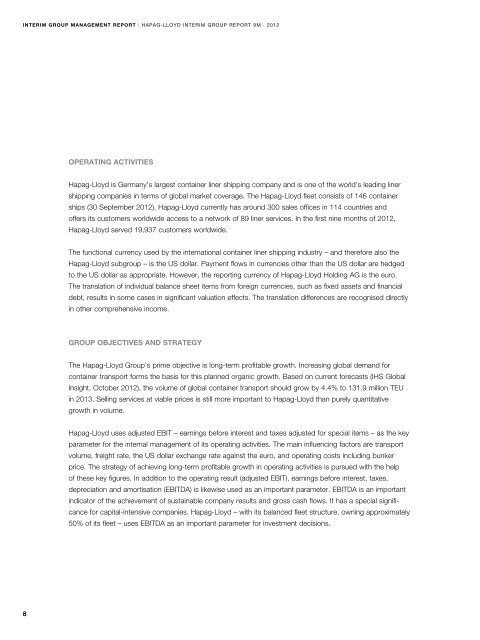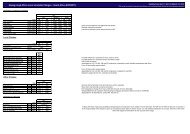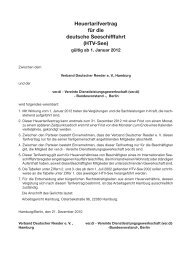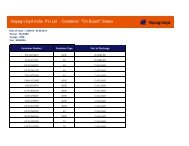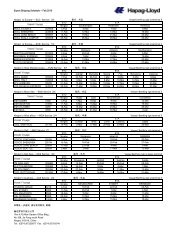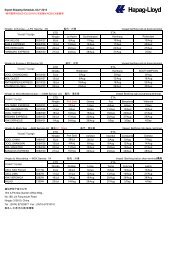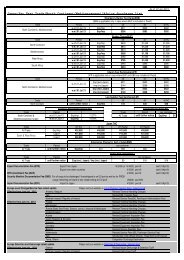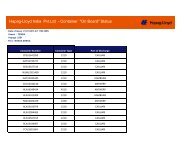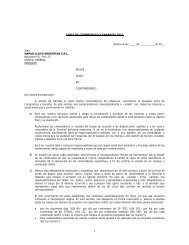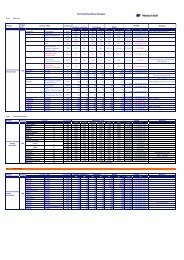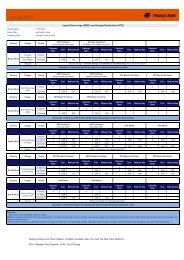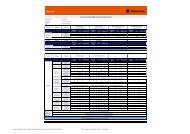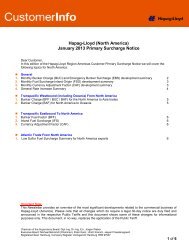Open print version - Hapag-Lloyd
Open print version - Hapag-Lloyd
Open print version - Hapag-Lloyd
Create successful ePaper yourself
Turn your PDF publications into a flip-book with our unique Google optimized e-Paper software.
interim group management report I hapag-lloyd interim group report 9M · 2012<br />
Operating activities<br />
<strong>Hapag</strong>-<strong>Lloyd</strong> is Germany’s largest container liner shipping company and is one of the world’s leading liner<br />
shipping companies in terms of global market coverage. The <strong>Hapag</strong>-<strong>Lloyd</strong> fleet consists of 146 container<br />
ships (30 September 2012). <strong>Hapag</strong>-<strong>Lloyd</strong> currently has around 300 sales offices in 114 countries and<br />
offers its customers worldwide access to a network of 89 liner services. In the first nine months of 2012,<br />
<strong>Hapag</strong>-<strong>Lloyd</strong> served 19,937 customers worldwide.<br />
The functional currency used by the international container liner shipping industry – and therefore also the<br />
<strong>Hapag</strong>-<strong>Lloyd</strong> subgroup – is the US dollar. Payment flows in currencies other than the US dollar are hedged<br />
to the US dollar as appropriate. However, the reporting currency of <strong>Hapag</strong>-<strong>Lloyd</strong> Holding AG is the euro.<br />
The translation of individual balance sheet items from foreign currencies, such as fixed assets and financial<br />
debt, results in some cases in significant valuation effects. The translation differences are recognised directly<br />
in other comprehensive income.<br />
Group objectives and strategy<br />
The <strong>Hapag</strong>-<strong>Lloyd</strong> Group’s prime objective is long-term profitable growth. Increasing global demand for<br />
container transport forms the basis for this planned organic growth. Based on current forecasts (IHS Global<br />
Insight, October 2012), the volume of global container transport should grow by 4.4% to 131.9 million TEU<br />
in 2013. Selling services at viable prices is still more important to <strong>Hapag</strong>-<strong>Lloyd</strong> than purely quantitative<br />
growth in volume.<br />
<strong>Hapag</strong>-<strong>Lloyd</strong> uses adjusted EBIT – earnings before interest and taxes adjusted for special items – as the key<br />
parameter for the internal management of its operating activities. The main influencing factors are transport<br />
volume, freight rate, the US dollar exchange rate against the euro, and operating costs including bunker<br />
price. The strategy of achieving long-term profitable growth in operating activities is pursued with the help<br />
of these key figures. In addition to the operating result (adjusted EBIT), earnings before interest, taxes,<br />
depreciation and amortisation (EBITDA) is likewise used as an important parameter. EBITDA is an important<br />
indicator of the achievement of sustainable company results and gross cash flows. It has a special significance<br />
for capital-intensive companies. <strong>Hapag</strong>-<strong>Lloyd</strong> – with its balanced fleet structure, owning approximately<br />
50% of its fleet – uses EBITDA as an important parameter for investment decisions.<br />
8


